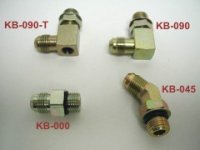Captain Avgas
Well Known Member
I've attached a Vans Aircraft photo of inlet and outlet fitting they sell for the Lycoming mechanical fuel pump. These fittings screw into the fuel pump with a straight thread that incorporates an o-ring. I believe the same o-ring is used on each fitting.
I want to replace my o-rings. Does anybody here know authoritatively (not guessing) what spec these o-rings are.
I suspect they are either an MS29513-112 or they could be an MS29512-06. Or these could be interchangeable.
Vans doesn't seem to list these o-rings as spares. Feedback would be appreciated.

I want to replace my o-rings. Does anybody here know authoritatively (not guessing) what spec these o-rings are.
I suspect they are either an MS29513-112 or they could be an MS29512-06. Or these could be interchangeable.
Vans doesn't seem to list these o-rings as spares. Feedback would be appreciated.





